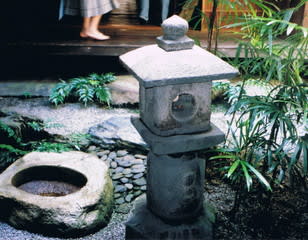The seventh Ogawa Jihei (1860-1933) known as "Ueji(植治)"is a great master of garden maiking in the Meiji era.
He is called by various honorific titles: "one of three greatest Japanese garden designers", "the pioneer of modern Japanese gardens" or "a magician of water".
His masterpieces are villas' gardens in the vicinity of Nanzen-ji temple such as the Murin-an garden.
However this garden of "Namikawa Cloisonne Museum of Kyoto" is notable particularly as his debut work.
Yasuyuki Namikawa is a great master of Japan's cloisonne ware. The building below built in 1894 was his house and atelier, and it was opened to the public as a museum in 2003.

(Above: The view of the outside with a traditional Machiya-style)
Ueji had a genius for use of water in gardens and he already showed his talent in this garden, too.

Although there are a lot of attractive spots in the garden, the highlight is the water. The pond stretches under the eaves and the house looks as if floating on the water.

The water was supplied from Lake Biwa Canal that had been just opened. Ueji made many remarkable gardens making the most of the canal water in his life; this is the first example.

He made this garden in his early thirties, however when looking at it, we can anticipate his genius as a great garden designer.
For further information: Namikawa Cloisonne Museum of Kyoto





























